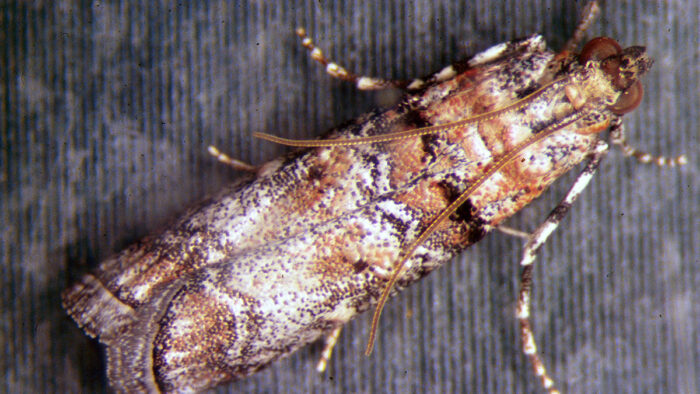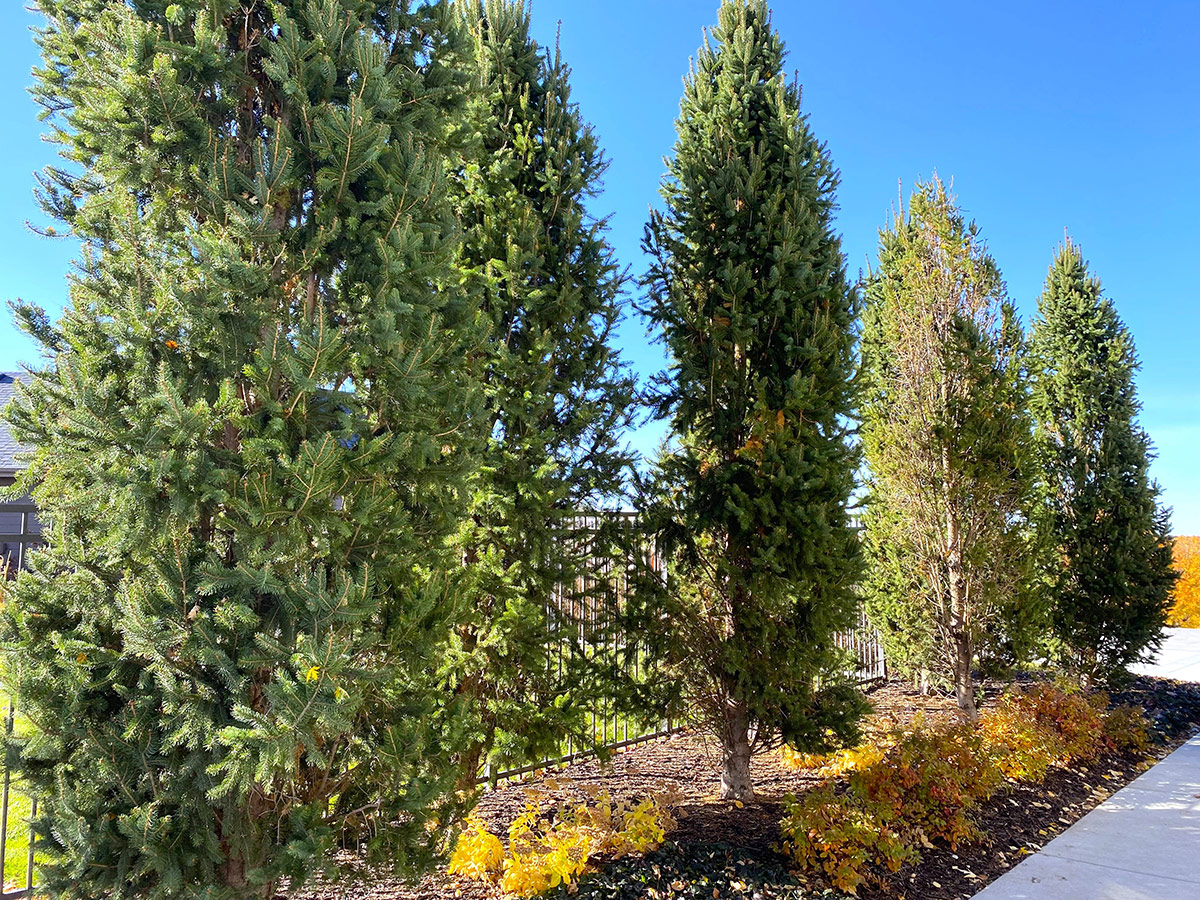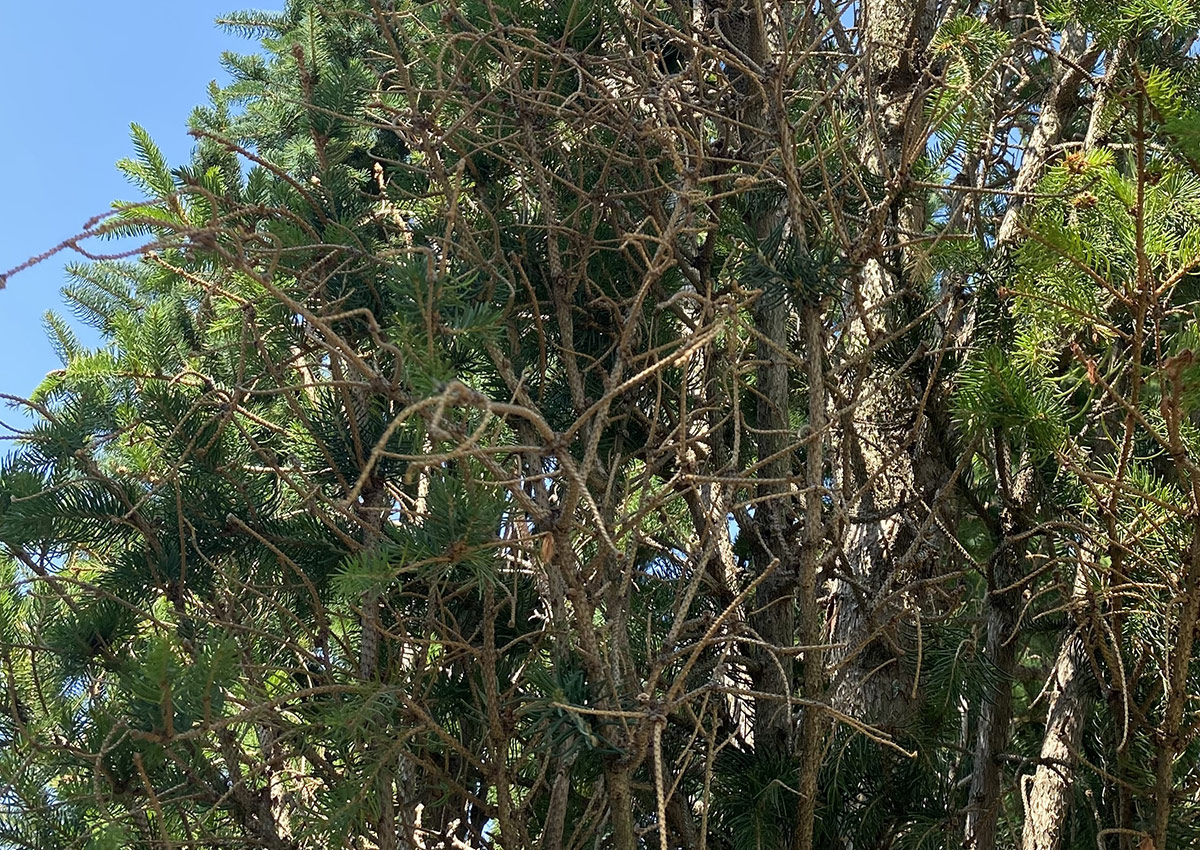
First found in the United States in 1879, Zimmerman pine moth (Dioryctria zimmermani) is a small gray insect with zigzag lines of red and gray and a wingspan of 1 to 1½ inches. The adult moths are rarely seen, as they are active only at night. Females lay 20 to 30 eggs that are cream colored at first and then turn brown as they develop. These are laid under the bark near the wounds created by their boring into the tree. When hatched, the larvae grow into brown-headed ¾-inch-long caterpillars with bodies that vary from pink to green and are covered with black spots. Wintering over at the end of tunnels bored under the bark, they emerge in late spring to continue their life cycle.
Which Midwest conifer species are susceptible to Zimmerman pine moth?
Zimmerman pine moth (ZPM) has become one of the most economically destructive pests of conifers in the Midwest. It causes severe damage to most pine species (Pinus spp., Zones 2–11) in the north central part of our country and also is known to infest spruce (Picea spp., Zones 2–9). Conifer species that are commonly grown in our area and susceptible to ZPM include the following:
- Norway spruce (Picea abies, Zones 3–8)
- Black hills spruce (Picea glauca var. densata, Zones 3–6)
- Colorado spruce (Picea pungens, Zones 2–8)
- Jack pine (Pinus banksiana, Zones 3–8)
- Swiss stone pine (Pinus cembra, Zones 3–7)
- Lodgepole pine (Pinus contorta, Zones 6–8)
- Mugo pine (Pinus mugo, Zones 3–7)
- Austrian pine (Pinus nigra, Zones 5–8)
- Western yellow pine (Pinus ponderosa, Zones 5–8)
- Red pine (Pinus resinosa, Zones 3–7)
- Eastern white pine (Pinus strobus, Zones 4–9)
- Douglas fir (Pseudotsuga taxifolia, Zones 5–7)

What does a Zimmerman pine moth infestation look like?
Early evidence of a ZPM outbreak is usually the wilting and browning of new growth. Terminal branches that are infested turn downward into a shepherd’s-crook shape. If untreated, the branch will ultimately die and break off. Depending upon the size of the tree, this may be the top of the tree or a side branch. Typically, ZPM attacks trees above eye level, which makes detecting them difficult before damage is visible.

What should I do if Zimmerman pine moth is in my area?
If you are aware of active ZPMs in the area, you can identify their presence before significant damage is done by looking for evidence of their bore holes. They prefer to attack either at or below the spot where whorls of branches extend from the trunk, and masses of soft resin, white with sawdust or caterpillar waste, indicate an active infestation site. These moths appear to have a preference for trees with wounds, that are unhealthy or stressed, or that have been infested before.
Controlling ZPM starts by providing your trees with the best growing environment possible. In the landscape, supply adequate amounts of water and apply mulch to maintain soil moisture. If in spite of your best efforts to keep your conifers healthy ZPM shows up, there are no natural or organic methods to control it. Three insecticides have been shown to be effective in managing them. Of the three, only one is available in retail stores–Permethrin—which is the active ingredient in Hi-Yield Turf and Termite as well as Ornamental 38 Plus. Before applying any chemical controls, be sure to read the label and follow the instructions. The other products, Chlorantraniliprole and Bifenthrin, should only be applied by a certified professional.
With the life cycle of ZPM there are only two periods of time when the caterpillars are outside of their tunnels, making these the most effective times to spray with insecticides. Sprays will not be able to reach the caterpillars once they have returned to the tunnels. The first time to spray is when caterpillars that have wintered over begin to emerge in the spring. Depending upon the weather, this is typically sometime in April. The second time when spraying is effective is late summer when eggs are being laid and hatching. This should occur in late July through August.
ZPM has been proven to be highly destructive in both residential and commercial landscapes. Due to its aggressive nature, commercial tree farms need to be more ruthless in their controls by removing infected trees as quickly as possible to stop the spread. Early detection and action can reduce the need for removing trees in the home garden. Make it a habit to observe your plant material for anomalies and discolorations that could indicate a pest has taken up residence. When necessary, consult your local horticultural professionals or online resources for help to identify the problem and the appropriate course of action, and report your finding to your local cooperative extension service for confirmation and to help prevent the spread. With vigilance and treatment, most problems can be overcome, but not all.
—Marti Neely, FAPLD, owns and operates Marti Neely Design and Associates in Omaha, Nebraska.


















Comments
Log in or create an account to post a comment.
Sign up Log in